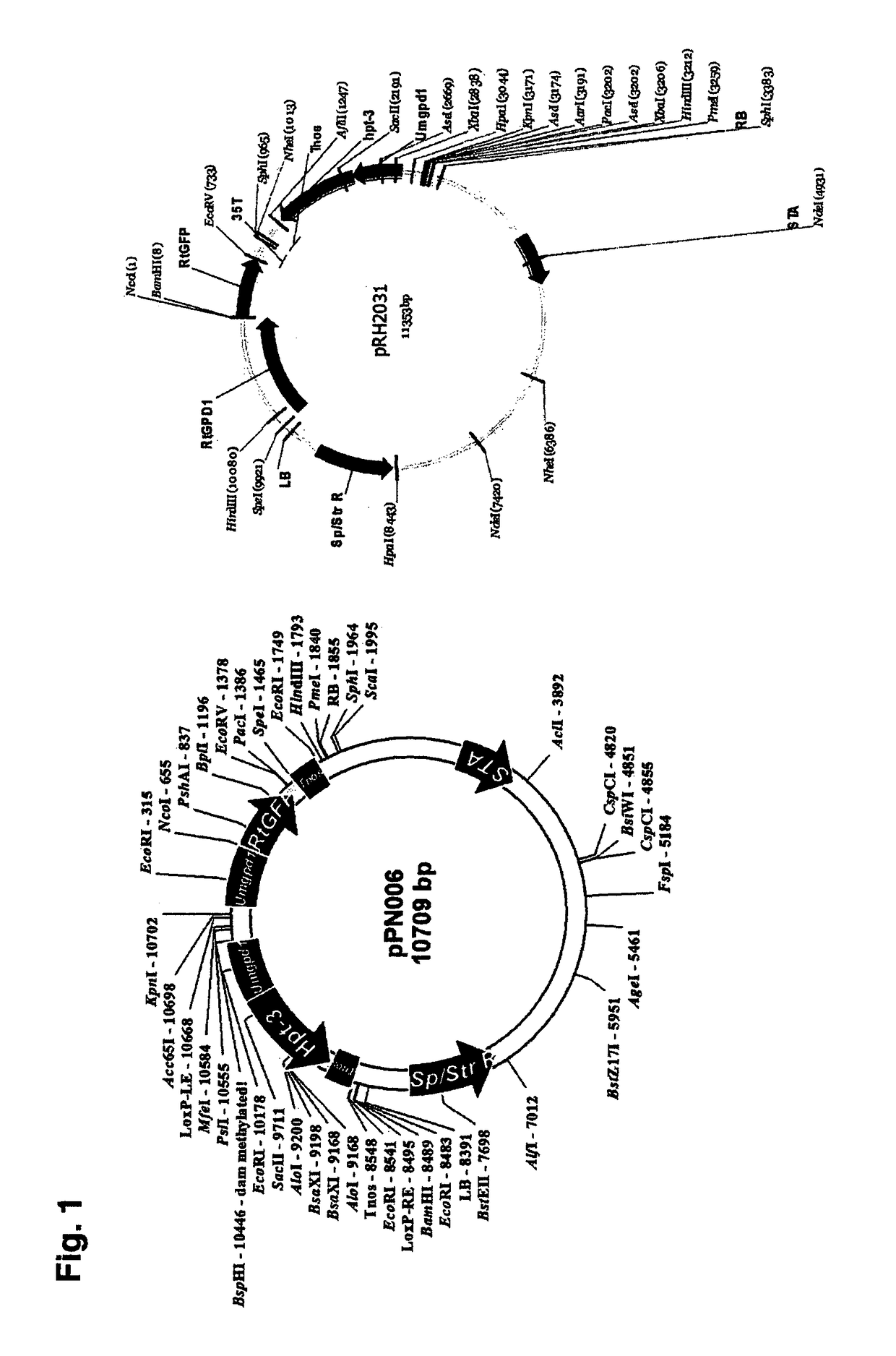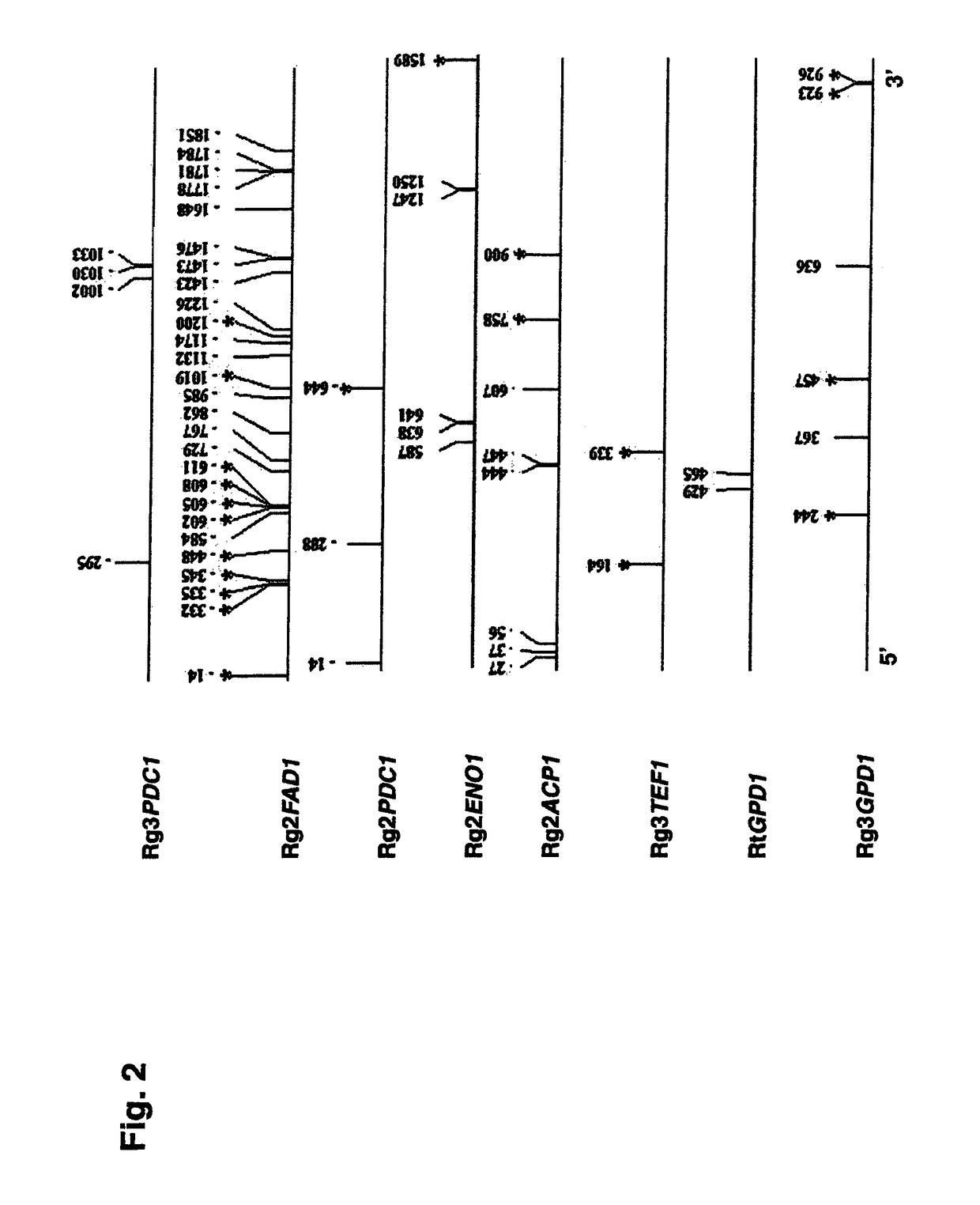Polynucleotide sequences from rhodosporidium and rhodotorula and use thereof
a technology of rhodosporidium and rhodotorula, applied in the field of fungal biotechnology, can solve the problems of even more unpredictable activity of the promoter in heterologous host species, and achieve the effect of strengthening gene expression and strong gene expression
- Summary
- Abstract
- Description
- Claims
- Application Information
AI Technical Summary
Benefits of technology
Problems solved by technology
Method used
Image
Examples
example 1
Culture of Microbial Strains and Basic Molecular Methods
[0041]Rhodosporidium toruloides strain ATCC10657 (referred to as Rt1), and Rhdotorula glutinis strain ATCC204091 (referred to as Rg2), Pseudozyma aphidis ATCC32657, were sourced from the American Type Culture Collections (ATCC). Sporobolomyces roseus FGSC 10293 (IAM13481) and Rhodotorula graminis WP1 (FGSC WP1) (referred to as Rg3) were obtained from Fungal Genetics Stock Center (University of Missouri, USA). Ustilago maydis strain and Agrobacterium tumefaciens strain AGL-1 have been described (Ji et al., 2010; Lazo et al., 1991). Escherichia coli strain XL1-Blue was used for routine plasmid manipulation and amplification. Fungal strains were cultured at 28° C. in YPD broth (1% yeast extract, 2% peptone, 2% glucose) or on solid potato-dextrose agar (PDA). A. tumefaciens was cultured at 28° C. in either liquid or solid 2YT medium (1.6% tryptone, 1% yeast extract, 0.5% NaCl). E. coli was grown in LB broth or on solid LB agar.
[004...
example 2
Agrobacterium tumefaciens-Mediated Transformation (ATMT)
[0043]ATMT was performed essentially as described previously for R. toruloides, S. roseus, U maydis and Pseudozyma aphidis(Ji, et al., 2010; Liu, et al, 2012). Co-culturing of fungal cells and Agrobacterium donors were done at pH5.6, 24° C. for 2.5-3 days on nylon membranes and selection was done on YPD plates containing 300 μg / ml cefotaxime and 150-300 μg / ml (150 μg / ml for R. toruloides, R. glutinis, and 300 μg / ml for P. aphidis and S. roseus) hygromycin B at 28° C. for 3-5 days.
example 3
Cloning of Promoters
[0044]Based on the published EST sequence abundance in various media (Ho et al, 2007), we selected a number of genes (Table 1) as potential source of strong promoters for Rhodosporidium and Rhodotorula. Other candidate genes include those encoding proteins in the fatty acid biosynthesis in Rhodosporidium and Rhodotorula, e.g., acetyl-CoA synthase (ACC1), acyl-CoA carrier protein (ACP1), pyruvate decarboxylase (PDC1) and nitrate regulated gene (NAR1). Ustilago maydis CDS sequences were searched against the Rhodosporidium and Rhodotorula genome database.
[0045]
TABLE 1Candidate Genes with Strong PromotercarbonNitrogenCompletestarvationstarvationdormantMedium*media*media*teliospore*DescriptionMUMDB ID718223glyceraldehyde 3-phosphateum02491dehydrogenase35542211probable TAL1 - transaldolaseum0413881260probable Actinum11232107796532probable ubiquitin / ribosomalum04588protein S27a fusion protein14654168probable FPR1 - peptidyl-prolylum11054cis-trans isomerase,FK506-binding...
PUM
| Property | Measurement | Unit |
|---|---|---|
| diameter | aaaaa | aaaaa |
| pH | aaaaa | aaaaa |
| pH | aaaaa | aaaaa |
Abstract
Description
Claims
Application Information
 Login to View More
Login to View More - R&D
- Intellectual Property
- Life Sciences
- Materials
- Tech Scout
- Unparalleled Data Quality
- Higher Quality Content
- 60% Fewer Hallucinations
Browse by: Latest US Patents, China's latest patents, Technical Efficacy Thesaurus, Application Domain, Technology Topic, Popular Technical Reports.
© 2025 PatSnap. All rights reserved.Legal|Privacy policy|Modern Slavery Act Transparency Statement|Sitemap|About US| Contact US: help@patsnap.com



